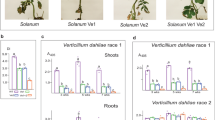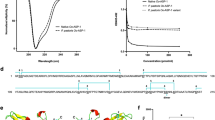Abstract
In planta expression of recombinant antibodies recognizing pathogen-specific antigens has been proposed as a strategy for crop protection. We report the expression of fusion proteins comprising a Fusarium-specific recombinant antibody linked to one of three antifungal peptides (AFPs) as a method for protecting plants against fungal diseases. A chicken-derived single-chain antibody specific to antigens displayed on the Fusarium cell surface was isolated from a pooled immunocompetent phage display library. This recombinant antibody inhibited fungal growth in vitro when fused to any of the three AFPs. Expression of the fusion proteins in transgenic Arabidopsis thaliana plants conferred high levels of protection against Fusarium oxysporum f.sp. matthiolae, whereas plants expressing either the fungus-specific antibody or AFPs alone exhibited only moderate resistance. Our results demonstrate that antibody fusion proteins may be used as effective and versatile tools for the protection of crop plants against fungal infection.
This is a preview of subscription content, access via your institution
Access options
Subscribe to this journal
Receive 12 print issues and online access
$209.00 per year
only $17.42 per issue
Buy this article
- Purchase on Springer Link
- Instant access to full article PDF
Prices may be subject to local taxes which are calculated during checkout






Similar content being viewed by others
References
Agrios, G.N. Plant Pathology, edn. 4, (Academic Press, San Diego, 1997).
Windels, C.E. Economic and social impacts of Fusarium head blight: changing farms and rural communities in the northern great plains. Phytopathology 90, 17–21 (2000).
Parry, D., Jenkinson, P. & Mcleod, L. Fusarium ear blight (scab) in small grain cereals—a review. Plant Pathol. 44, 207–238 (1995).
Placinta, C.M., D'Mello, J.P.F. & Macdonald, A.M.C. A review of worldwide contamination of cereal grains and animal feed with Fusarium mycotoxins. Anim. Feed Sci. Technol. 78, 21–37 (1999).
Hayes, A.W. Mycotoxins: a review of biological effects and their role in human diseases. Clin. Toxicol. 17, 45–83 (1980).
Collinge, D.B. et al. Plant chitinases. Plant J. 3, 31–40 (1993).
Punja, Z.K. Genetic engineering of plants to enhance to resistance to fungal pathogens—a review of progress and future prospects. Can. J. Plant Pathol. 23, 216–235 (2001).
Grison, R. et al. Field tolerance to fungal pathogens of Brassica napus constitutively expressing a chimeric chitinase gene. Nat. Biotechnol. 14, 643–646 (1996).
Shah, D.M. Genetic engineering for fungal and bacterial diseases. Curr. Opin. Biotechnol. 8, 208–214 (1997).
Ma, J.K. et al. Generation and assembly of secretory antibodies in plants. Science 268, 716–719 (1995).
Little, M., Kipriyanov, S.M., Le Gall, F. & Moldenhauer, G. Of mice and men: hybridoma and recombinant antibodies. Immunol. Today 21, 364–370. (2000).
Giddings, G., Allison, G., Brooks, D. & Carter, A. Transgenic plants as factories for biopharmaceuticals. Nat. Biotechnol. 18, 1151–1155 (2000).
Jobling, S.A. et al. Immunomodulation of enzyme function in plants by single-domain antibody fragments. Nat. Biotechnol. 21, 77–80 (2003).
Schillberg, S., Zimmermann, S., Zhang, M.-Y. & Fischer, R. Antibody-based resistance to plant pathogens. Transgenic Res. 10, 1–12 (2001).
Tavladoraki, P. et al. Transgenic plants expressing a functional single-chain Fv antibody are specifically protected from virus attack. Nature 366, 469–472 (1993).
Voss, A. et al. Reduced virus infectivity in N. tabacum secreting a TMV-specific full size antibody. Mol. Breeding 1, 39–50 (1995).
Le Gall, F., Bove, J.M. & Garnier, M. Engineering of a single-chain variable-fragment (scFv) antibody specific for the stolbur phytoplasma (Mollicute) and its expression in Escherichia coli and tobacco plants. Appl. Environ. Microbiol. 64, 4566–4572 (1998).
Liu, S. & Anderson, J.A. Marker assisted evaluation of Fusarium head blight resistant wheat germplasm. Crop. Sci. 43, 760–766 (2003).
Liao, Y.-C., Kreuzaler, F., Fischer, R., Reisener, H.-J. & Tiburzy, R. Characterization of a wheat class Ib chitinase gene differentially induced in isogenic lines by infection with Puccinia graminis. Plant Science 103, 177–187 (1994).
Terras, F.R. et al. Small cysteine-rich anti-fungal proteins from radish: their role in host defense. Plant Cell 7, 573–588 (1995).
Wnendt, S., Ulbrich, N. & Stahl, U. Cloning and nucleotide sequence of a cDNA encoding the anti-fungal- protein of Aspergillus giganteus and preliminary characterization of the native gene. Nucleic Acids Res. 18, 3987 (1990).
Kathuria, S. et al. Efficacy of plant-produced recombinant antibodies against HCG. Hum. Reprod. 17, 2054–2061 (2002).
Clough, S.J. & Bent, A.F. Floral dip: a simplified method for Agrobacterium-mediated transformation of Arabidopsis thaliana. Plant J. 16, 735–743 (1998).
Tierens, K.F. et al. Study of the role of antimicrobial glucosinolate-derived isothiocyanates in resistance of Arabidopsis to microbial pathogens. Plant Physiol. 125, 1688–1699 (2001).
Stewart, C.N. Jr. The utility of green fluorescent protein in transgenic plants. Plant Cell Rep. 20, 376–382 (2001).
Benhamou, N., Broglie, K., Broglie, R. & Chet, I. Antifungal effect of bean endochitinase on Rhizoctonia solani: ultrastructural changes and cytochemical aspects of chitin breakdown. Can. J. Microbiol. 39, 318–328 (1993).
Thevissen, K. et al. Fungal membrane responses induced by plant defensins and thionins. J. Biol. Chem. 271, 15018–15025 (1997).
Lacadena, J. et al. Characterization of the antifungal protein secreted by the mould Aspergillus giganteus. Arch. Biochem. Biophys. 324, 273–281 (1995).
Hiatt, E.E. 3rd, Hill, N.S. & Hiatt, E.N. Monoclonal antibodies incorporated into Neotyphodium coenophialum fungal cultures: inhibition of fungal growth and stability of antibodies. Fungal Genet. Biol. 33, 107–114 (2001).
Schoffelmeer, E.A., Klis, F.M., Sietsma, J.H. & Cornelissen, B.J. The cell wall of Fusarium oxysporum. Fungal Genet. Biol. 27, 275–282 (1999).
Thornton, C.R., Dewey, F.M. & Gilligan, C.A. Production and characterization of a monoclonal antibody raised against surface antigens from mycelium of Gaeumannomyces graminis var. tritici: Evidence for an extracellular polyphenol oxidase. Phytopathology 87, 123–131 (1997).
Duvick, J.P., Rood, T., Rao, A.G. & Marshak, D.R. Purification and characterization of a novel antimicrobial peptide from maize (Zea mays L.) kernels. J. Biol. Chem. 267, 18814–18820 (1992).
Zhang, M. et al. GST fusion proteins cause false positives during selection of viral movement protein specific single chain antibodies. J. Virol. Methods 91, 139–147 (2001).
Hoogenboom, H.R. et al. Multi-subunit proteins on the surface of filamentous phage: methodologies for displaying antibody (Fab) heavy and light chains. Nucleic Acids Res. 19, 4133–4137 (1991).
Whitlow, M. et al. An improved linker for single-chain Fv with reduced aggregation and enhanced proteolytic stability. Protein Eng. 6, 989–995 (1993).
Gough, K.C. et al. Selection of phage antibodies to surface epitopes of Phytophthora infestans. J. Immunol. Methods 228, 97–108 (1999).
Sambrook, J., Fritsch, E.F. & Maniatis, T. Molecular Cloning—A Laboratory Manual, edn. 3 (Cold Spring Harbor Press, Cold Spring Harbor, NY, 1996).
Reichel, C. et al. Enhanced green fluorescence by the expression of an Aequorea victoria green fluorescence protein mutant in mono-and dicotyledonous plant cells. Proc. Natl. Acad. Sci. USA 93, 5888–5893 (1996).
Rademacher, T. et al. An engineered phosphoenolpyruvate carboxylase redirects carbon and nitrogen flow in transgenic potato plants. Plant J. 32, 25–39 (2002).
Reglinski, T. et al. Systemic acquired resistance to Sclerotinia sclerotiorum in kiwifruit vines. Physiol. Mol. Plant Pathol. 58, 111–118 (2001).
Aguilera, O., Ostolaza, H., Quiros, L.M. & Fierro, J.F. Permeabilizing action of an antimicrobial lactoferricin-derived peptide on bacterial and artificial membranes. FEBS Lett. 462, 273–277 (1999).
Acknowledgements
We thank N. Emans for fluorescence microscopy, S. Hellwig for fermentation of F. graminearum and S. Dorfmueller for valuable discussions. We also thank R. Twyman, P. Christou and N. Emans for critical reading of the manuscript. This project was supported by a state grant of Nordrhein-Westfalen to R.F.
Author information
Authors and Affiliations
Corresponding author
Ethics declarations
Competing interests
The authors declare no competing financial interests.
Rights and permissions
About this article
Cite this article
Peschen, D., Li, HP., Fischer, R. et al. Fusion proteins comprising a Fusarium-specific antibody linked to antifungal peptides protect plants against a fungal pathogen. Nat Biotechnol 22, 732–738 (2004). https://doi.org/10.1038/nbt970
Received:
Accepted:
Published:
Issue Date:
DOI: https://doi.org/10.1038/nbt970
This article is cited by
-
Seed-produced anti-globulin VHH-Fc antibodies retrieve globulin precursors in the insoluble fraction and modulate the Arabidopsis thaliana seed subcellular morphology
Plant Molecular Biology (2020)
-
Assigning biological function using hidden signatures in cystine-stabilized peptide sequences
Scientific Reports (2018)
-
Leucine-rich-repeat-containing variable lymphocyte receptors as modules to target plant-expressed proteins
Plant Methods (2017)
-
Production of a phage-displayed mouse ScFv antibody against fumonisin B1 and molecular docking analysis of their interactions
Biotechnology and Bioprocess Engineering (2016)
-
How to effectively deploy plant resistances to pests and pathogens in crop breeding
Euphytica (2013)



